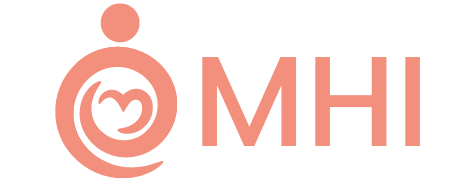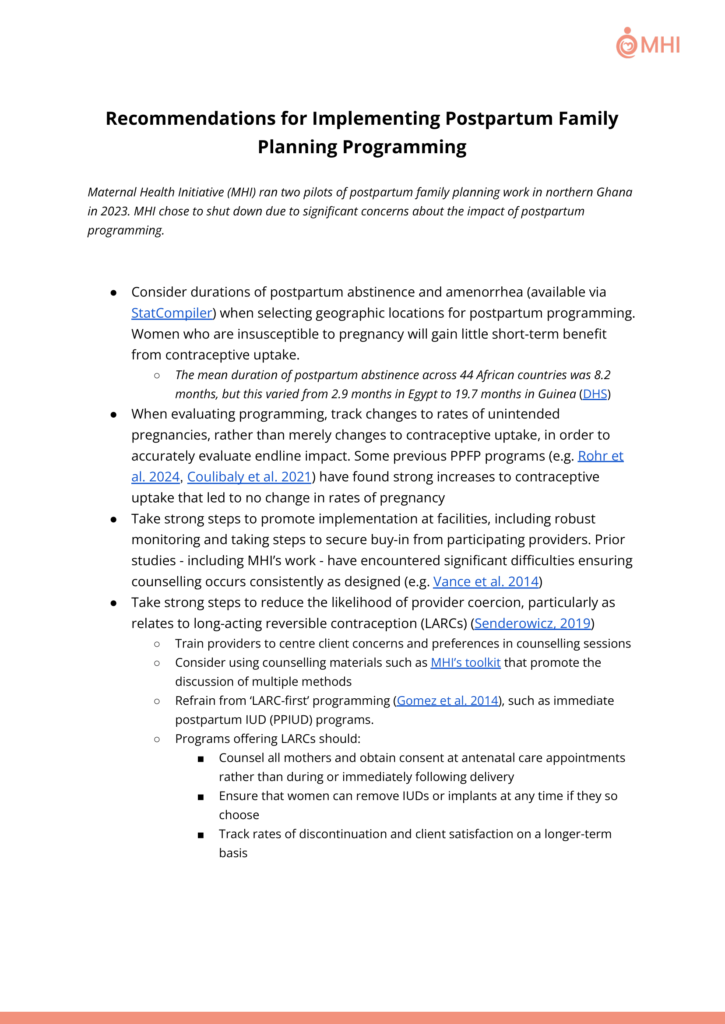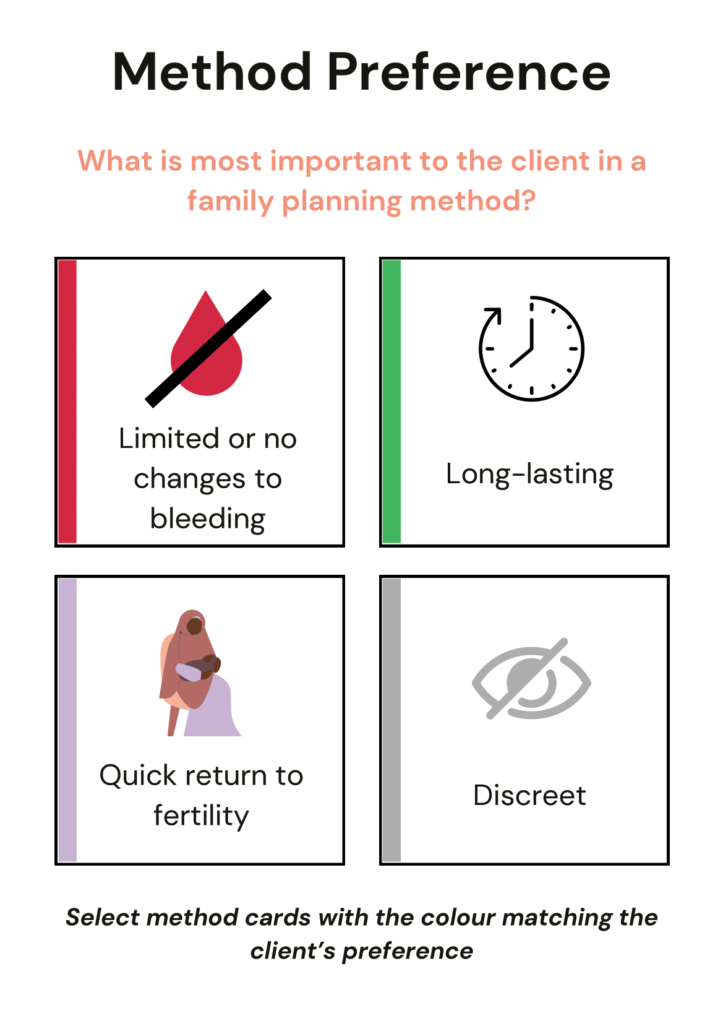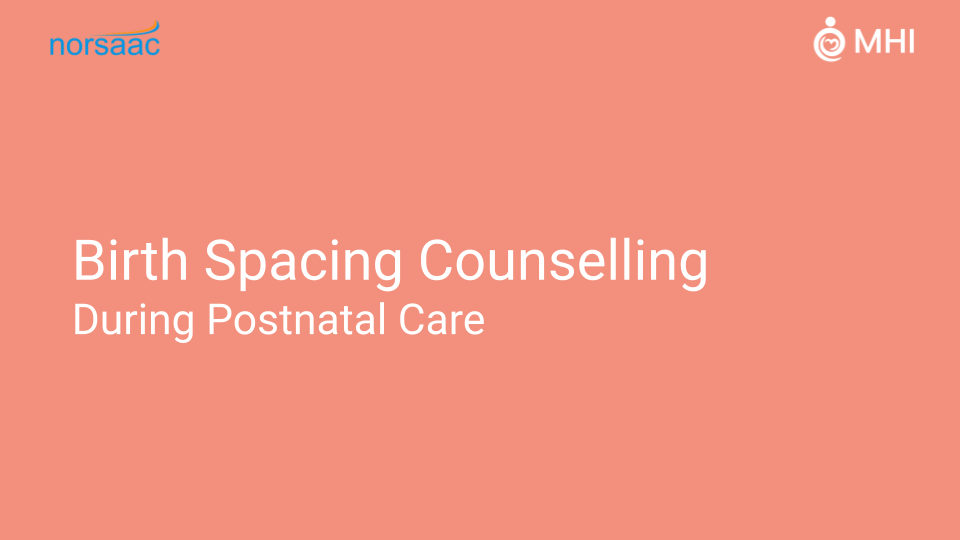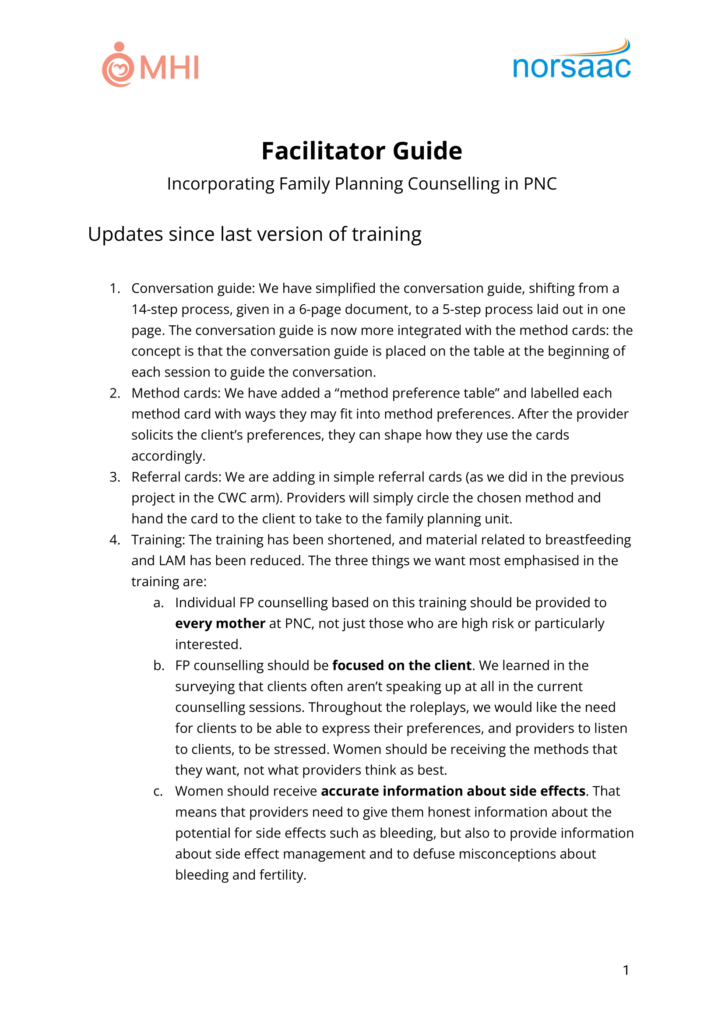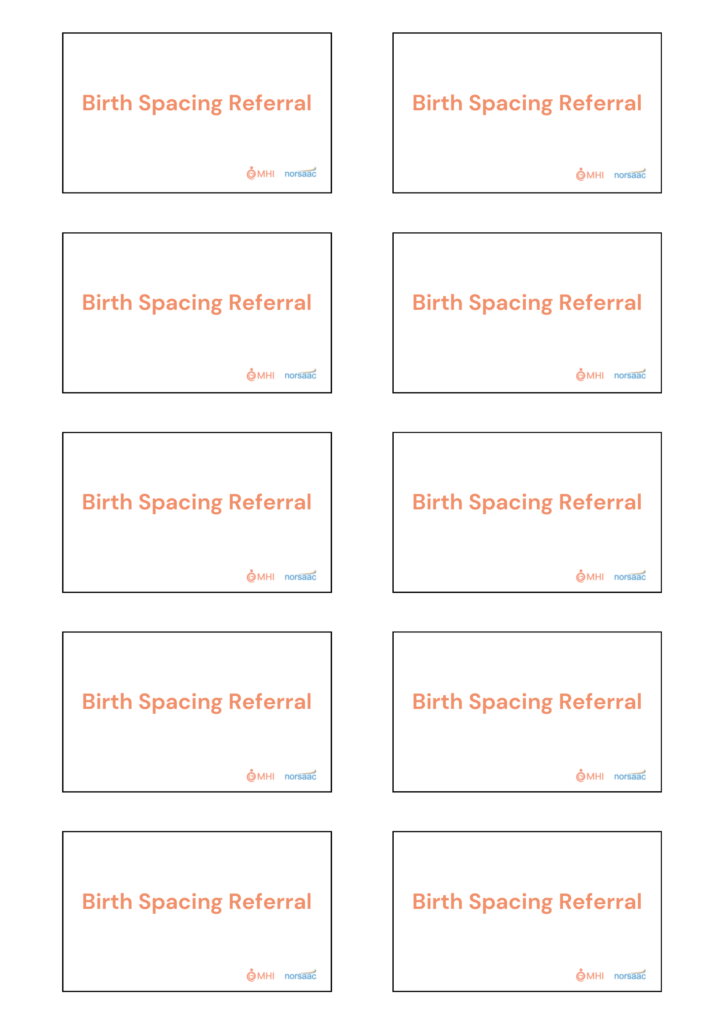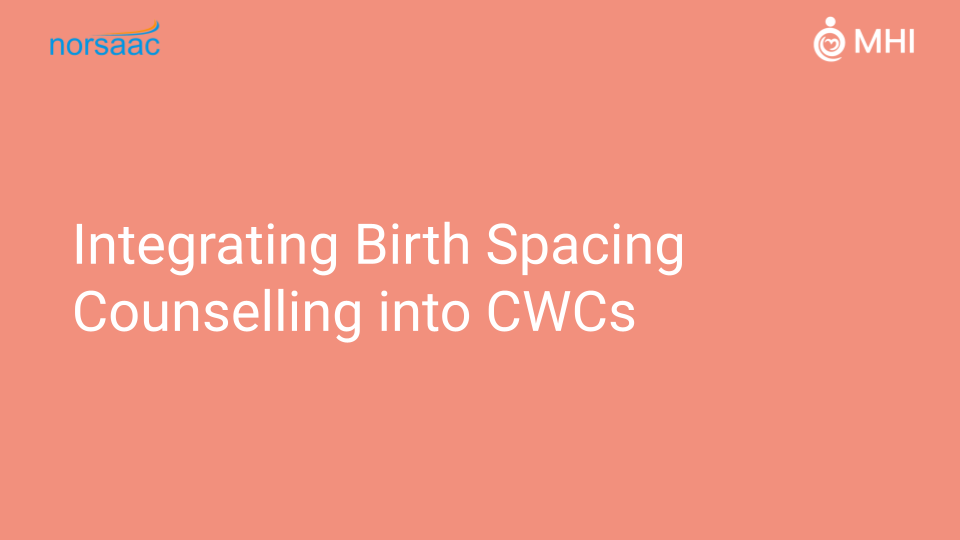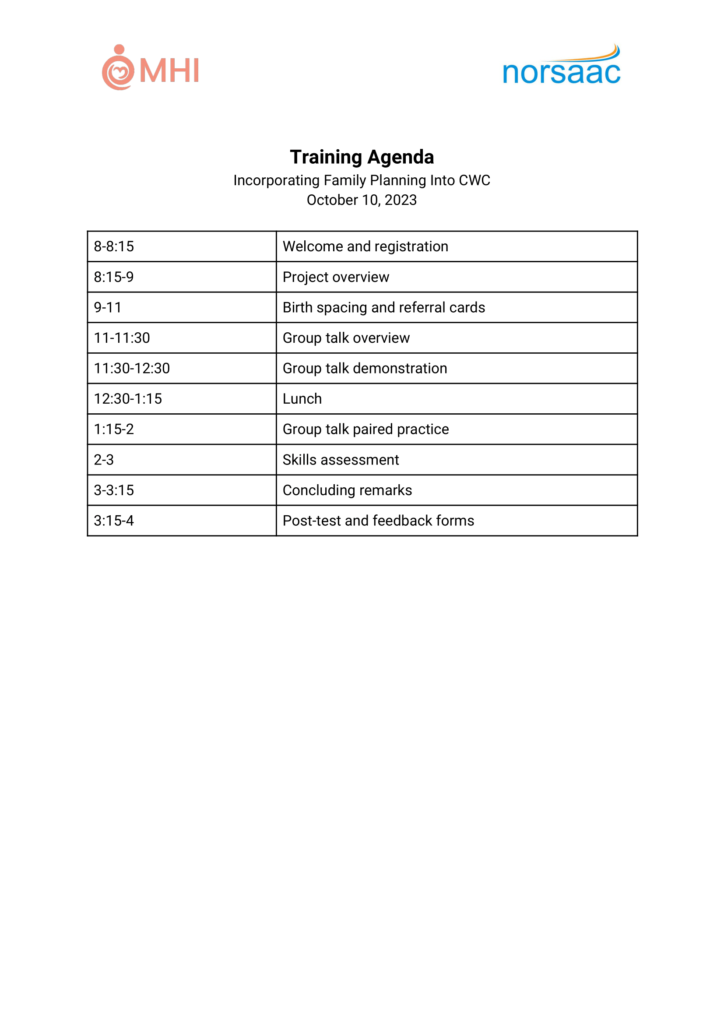Programming Resources
Sharing the materials, research, and tools developed by MHI’s team for use by other actors
Introduction
The Maternal Health Initiative has worked to test and deliver a scalable programming of high-quality family planinng counselling. Through 2023, the MHI team developed a suite of counselling materials targeted at maximising the quality of postpartum family planning counselling. These underwent multiple iterations, with the copies shared here representing the final versions produced. Tailored materials were developed for counselling during postnatal care (PNC) and child welfare clinics (CWC) respectively. For more information about our pilot and the context for which these materials were developed, please refer to our pilot project report.
MHI’s goal to improve maternal and child health outcomes is one that is shared by many other organisations. We hope that our materials, research, and tools can prove useful to the wider community of family planning and global health practitioners. As such, we have shared open-access, downloadable copies of these documents along with an explanation of how and why each was designed.
Thank you to the many team members, volunteers, and advisors instrumental in the process of creating these resources. Should you have questions about anything shared here, please reach out through our contact form.
Programming Solution Sets
Our Approach
The training and counseling resources on this page are intended for the integration of family planning guidance into routine care appointments. The materials are intended for use with every mother, not just those who are high risk or demonstrate particular interest. The counselling has been designed to be short and simple to deliver. Counselling should be an opportunity for all women to discuss and learn about contraceptive methods regardless of whether they plan to take up a method at this time or not.
In line with this, counselling should be focused on the client and tailored to their preferences. The design of the counselling materials reflects this, aiming to direct discussion to the particular interests and concerns of the client. Our surveying data suggested that counselling sessions often involved minimal or no input from the client, becoming more of a contraceptive lecture than a discussion.
The materials and approach they promote place a particular emphasis on providing accurate information around contraceptive side effects. We found that many women had well-considered and accurate concerns around the impact of potential side effects on their lives (Polis et al., 2018; Bradley et al., 2009; Mohammed et al., 2020). Family planning counselling must provide an open space for discussing the real and significant side effects methods can cause. Our materials are designed to promote discussion of alternative methods with different side effect profiles rather than to diminish or dismiss the concerns women raise. That means providers must give
Finally, data collection from both providers and clients is crucial to understand whether counselling sessions are occurring, and if they are occurring in the client-focused manner intended. It is not enough to provide training or materials and count that as impact: we must ensure that counselling is occuring, and occuring in ways that promote genuine improvements in knowledge, choice, and outcomes.
Postnatal Care (PNC) Solution Set
Model of Counselling
Our postnatal care intervention consisted of the following three key objectives:
- Include family planning counselling as part of every 1:1 postnatal appointment they offer.
- Use MHI’s Counselling Guide as a framework for this discussion, with the Method Cards and Method Information Booklet used as key resources in this framework. The discussion should take around 20 minutes, depending on the number of questions from the client.
- Offer a method directly, or a referral to the family planning unit, for women who express an interest in taking up a method of birth spacing at the end of the counselling discussion.
Each provider was given a copy of the three key counselling materials: the ‘MHI Counselling Guide’, ‘Method Information Booklet’, and ‘Method Cards’.
The counselling guide provided an overall structure for the counselling session and acted as a job aid for remembering the training while delivering counselling. The method cards were designed for client-centred counselling, providing a visual tool for clients to indicate their key preferences and which kinds of methods they were most interested in. The ‘Method Information Booklet’ acted as a reference tool for providers to look up more complex or detailed information about different methods, including the following: side effect profiles; effectiveness; risk factors to screen for before method provision; and the mechanism for taking the method.
Finally, all facilities also received a large set of referral cards (as well as boxes for their storage and transfer). The referral cards were designed as a practical reminder and behavioural nudge to clients who expressed interest in a method that was not available for provision during the routine appointment, either due to stock shortages or the need for insertion by a trained specialist.
Key Materials: Counselling
This set of materials consists of four tools designed to be used together for effective, client-centred counselling on contraceptive options for mothers in the early postpartum (post-birth) period.
These materials are designed to integrate into existing systems of care. They can be used by non-specialist healthcare workers who receive basic guidance in family planning counselling. Counselling following this model is designed to be short enough to include as part of routine postnatal care sessions rather than for delivery as separate counselling.
Key Materials: Training
All healthcare workers involved in MHI’s programs recieved a one-day in-person training session. This was designed as a refresher training on family planning knowledge with a strong focus on the implementation of the specific counselling approach outlined by the materials above.
The materials used for these sessions can be used to train any healthcare workers with some prior exposure to family planning in how to deliver integrated postpartum family planning counselling.
Child Welfare Clinic (CWC) Solution Set
Model of Counselling
At the CWC session, providers were given a group talk flipchart, 1:1 counselling card, and referral cards for directing people to the Family Planning Unit. The child welfare clinic intervention was designed to consist of three key components – a group talk, one-to-one messaging, and a referral system:
- Include family planning messaging in every group talk given while women wait for their child to be called up for weighing and immunisation, using MHI’s streamlined ‘Birth Spacing Group Talk’ flipchart as a guide.
- Providers giving immunisations have a very short 1:1 family planning discussion with each woman as her child is vaccinated using the ‘Birth Spacing Card’.
- Offer women the option of a streamlined referral for family planning at the end of this one-to-one engagement, using a system of referral cards to make it simple for women to receive a method that day should they choose to do so.
Providers were asked to offer a short family planning group talk using the flip chart at every child immunisation session. The ‘Birth Spacing Group Talk’ flipchart was designed so that the group talk would take no more than 10 minutes and be feasible to implement even at busy CWC sessions. The flipchart leads providers and clients through a discussion of the range of methods available to clients, how to safely take methods and manage their side effects, and the benefits of receiving family planning counselling while at the facility.
The ‘Birth Spacing Card’ was designed for use by providers directly administering immunisations to children after they have been weighed and their health records have been recorded. Providers were asked to counsel every woman whose child they immunised. The card was designed so that the engagement would last 1-2 minutes at a maximum to ensure feasible implementation. This model was chosen to mirror the approach of Dulli et al. (2016).
A referral card system was paired with the ‘Birth Spacing Card’. All women who expressed interest in discussing family planning further received a referral card to take to the Family Planning Unit. These were designed to be discreet to pass between provider and client to maintain confidentiality.
Referral cards acted as a physical reminder to the client to follow up on their family planning interest while indicating to providers at the Family Planning Unit of the hospital that the client had already received some family planning guidance and could receive a streamlined version of standard counselling.
Finally, all providers received a ‘Method Information Booklet’ as a reference tool to answer more complex questions about contraceptive method use and provision.
Key Materials: Counselling
This set of materials consists of four tools designed to be used together for effective, client-centred counselling on contraceptive options for mothers attending child immunisation sessions at a local health facility (referred to as child welfare clinics in Ghana). These sessions typically occur between six weeks and two years after delivery and may include child weighing, Vitamin A supplementation, and other healthcare activities.
These materials are designed to integrate into existing systems of care. They can be used by non-specialist healthcare workers who receive basic guidance in family planning counselling. Counselling following this model is designed for integration into the existing structures of child immunisation sessions, with activity split between a group talk and one-to-one engagement during immunisation. As the structures of care vary between countries, the materials may require adaptation for use in contexts outside of Ghana.
Key Materials: Training
All healthcare workers involved in MHI’s programs recieved a one-day in-person training session. This was designed as a refresher training on family planning knowledge with a strong focus on the implementation of the specific counselling approach outlined by the materials above.
The materials used for these sessions can be used to train any healthcare workers with some prior exposure to family planning in how to deliver short family planning messaging as part of routine child immunisation sessions.
